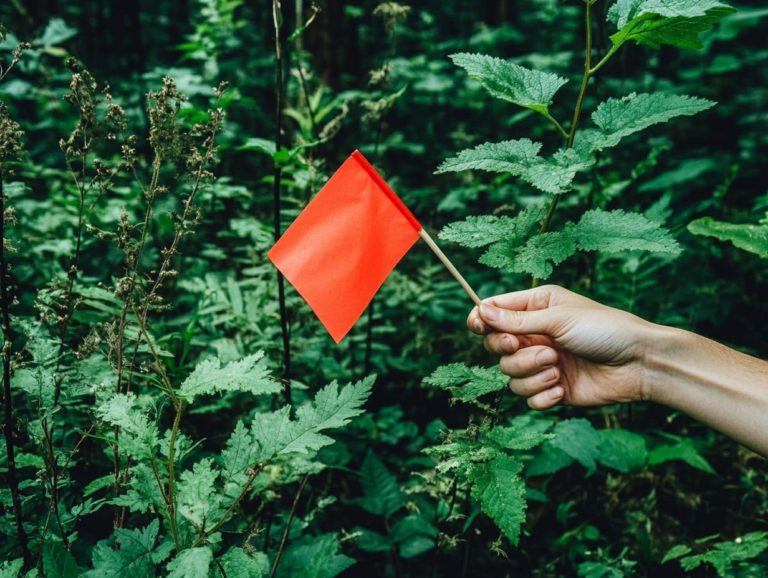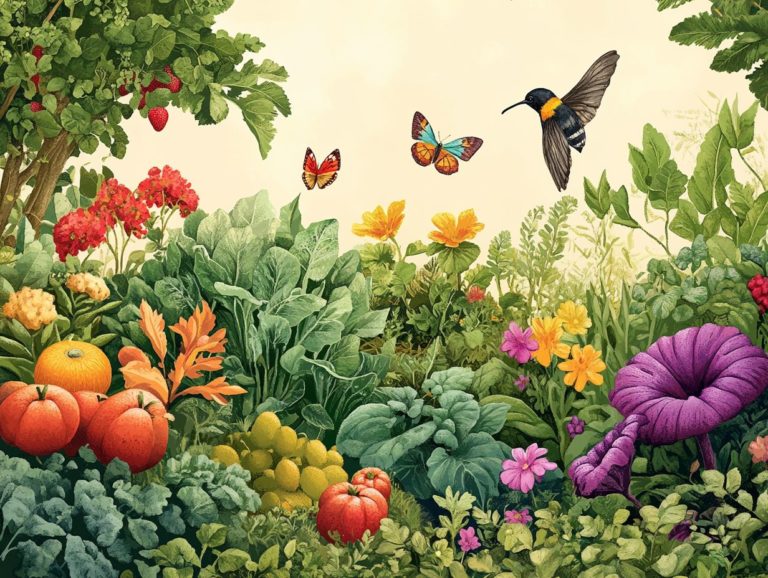5 Best Edible Plants for Spring Foraging
Spring unfolds with a dazzling palette, showing off flowers and warm weather while revealing a treasure trove of edible delights waiting to be unearthed in nature.
From the ever-familiar dandelion to the elusive morel mushroom, this season presents a remarkable selection of foraged foods that can elevate your meals and deepen your connection with the great outdoors.
Discover five of the finest edible plants to seek out this spring. We ll also share insights into the benefits and precautions of foraging, sustainable practices, and tips for seamlessly incorporating these wild wonders into your diet.
Whether you re an experienced forager or trying this adventure for the first time, everyone will find something exciting to enjoy!
Contents
Key Takeaways:
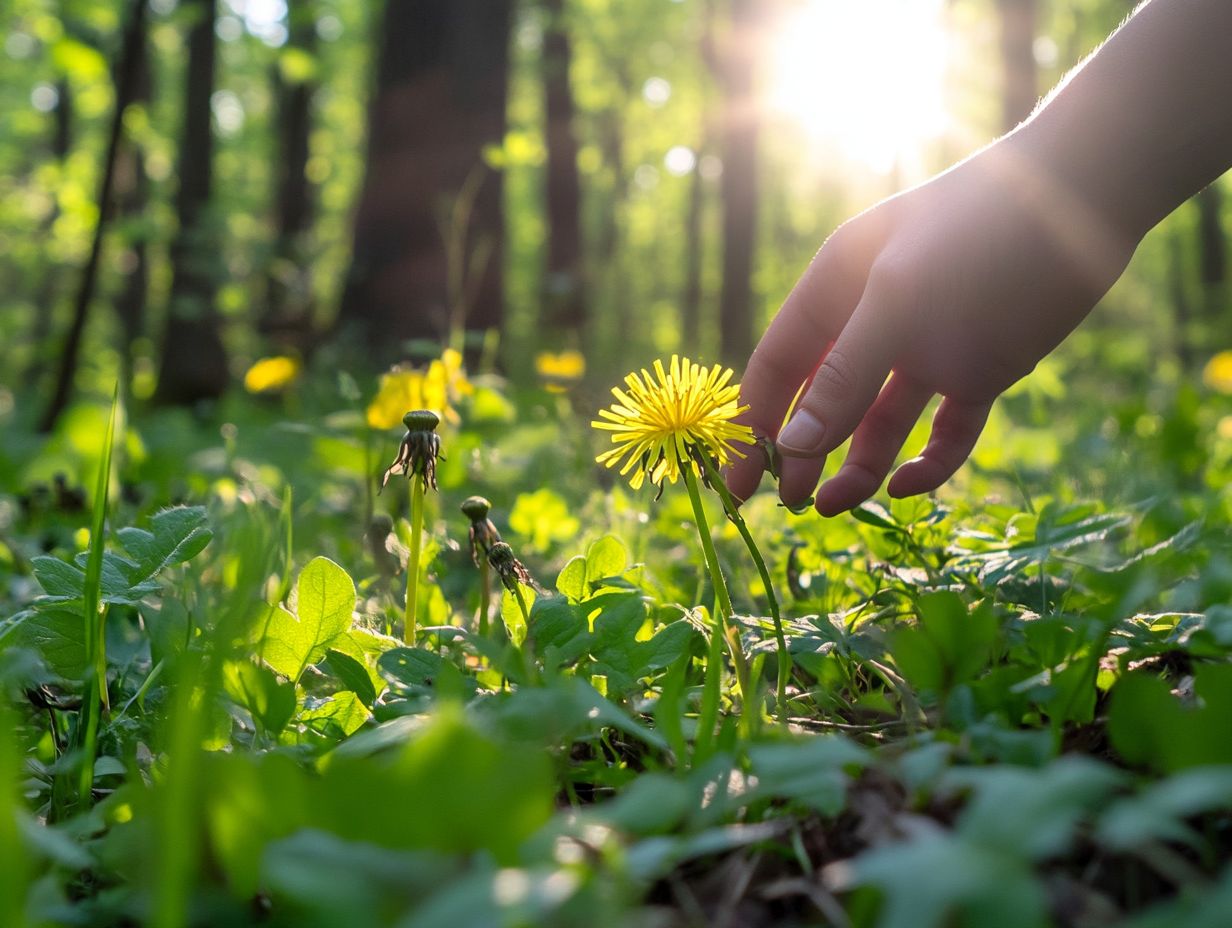
- Dandelions, wild garlic, nettles, fiddleheads, and morel mushrooms are the top 5 edible plants for spring foraging.
- Spring foraging is a popular activity that involves gathering wild edible plants.
- Foraging has numerous benefits, including connecting with nature, saving money, and promoting a healthy diet.
1. Dandelions
Dandelions, often dismissed as mere weeds, are resilient wild edible plants that grace early spring with their vibrant blooms. They offer culinary delights and a wealth of medicinal properties, making them a true gem in your foraging toolkit. For those interested in foraging, exploring the top 5 wild edibles for beginners can expand your knowledge further.
Their sunny yellow flowers, tender green leaves, and deep taproots are all entirely edible. You can use them in everything from wild salads to soothing teas. Learning how to properly harvest and prepare dandelions will elevate your foraging experience and deepen your appreciation for nature’s generous bounty.
Harvest the young leaves for a slightly bitter base in your salads, which pair wonderfully with a zesty citrus dressing or mingle nicely with other greens like arugula. The flowers, with their delightful sweetness, can be transformed into fritters or used as a cheerful garnish for various dishes. The roots can be roasted and ground to serve as a caffeine-free coffee alternative.
When foraging, keep an eye out for dandelions in sunny, open spaces. They are identifiable by their jagged leaves and single-stemmed yellow blooms. Be mindful to steer clear of treated lawns or areas that may be doused with pesticides to ensure your harvest is clean and healthy.
By weaving dandelions into your daily meals think refreshing dandelion and lemon tea or a splash of color in a vibrant spring veggie stir-fry you can forge a deeper connection with this often-overlooked superfood.
2. Wild Garlic
Wild garlic, with its captivating varieties like Garlic Mustard and Field Garlic, makes its grand entrance in early spring. It brings a delightful burst of flavor and nutritional benefits that foragers and chefs eagerly seek out.
You ll easily spot these plants thanks to their broad, green leaves and the unmistakable garlicky aroma that intensifies when crushed. As you forage, you might stumble upon their relatives, such as Ramps and Wild Onion, each boasting its unique traits.
In the kitchen, wild garlic can truly elevate your dishes with its mild yet pungent flavor profile. It s an excellent addition to pesto, soups, and salads. Beyond their culinary charm, these plants also come with a host of medicinal properties, including antibacterial and anti-inflammatory effects, traditionally used to promote digestive health.
When harvesting, it s essential to take only what you need, ensuring that you leave enough for the ecosystem to flourish. Sustainable foraging gathering food in a way that protects plants and wildlife not only honors nature but also enhances your culinary adventures.
Grab your basket and venture out this spring to discover nature’s hidden treasures!
3. Nettles
Stinging nettles are rich in nutrients and are wild edible plants that flourish in damp, shaded areas. Head out in early spring to forage these treasures! For additional options, consider exploring the top 5 edible flowers to gather in spring, as they provide an excellent source of vitamins and minerals and offer unique culinary opportunities.
To safely enjoy these remarkable plants, apply specific cooking methods that neutralize their sting, such as blanching or saut ing. By briefly boiling them, you render the offensive compounds harmless, revealing a rich, earthy flavor reminiscent of spinach.
Stinging nettles are also packed with:
- Iron – supports energy levels
- Calcium – strengthens bones
- Vitamins A and C – boost the immune system
This versatility makes them a fantastic addition to various dishes. In herbal medicine, they ve gained recognition for their anti-inflammatory properties and ability to alleviate allergies.
Historically, you ll find them in teas, soups, and even as natural remedies for various ailments, beautifully bridging culinary arts and time-honored health practices.
Foraging for nettles not only nourishes the body but also connects you with nature.
4. Fiddleheads
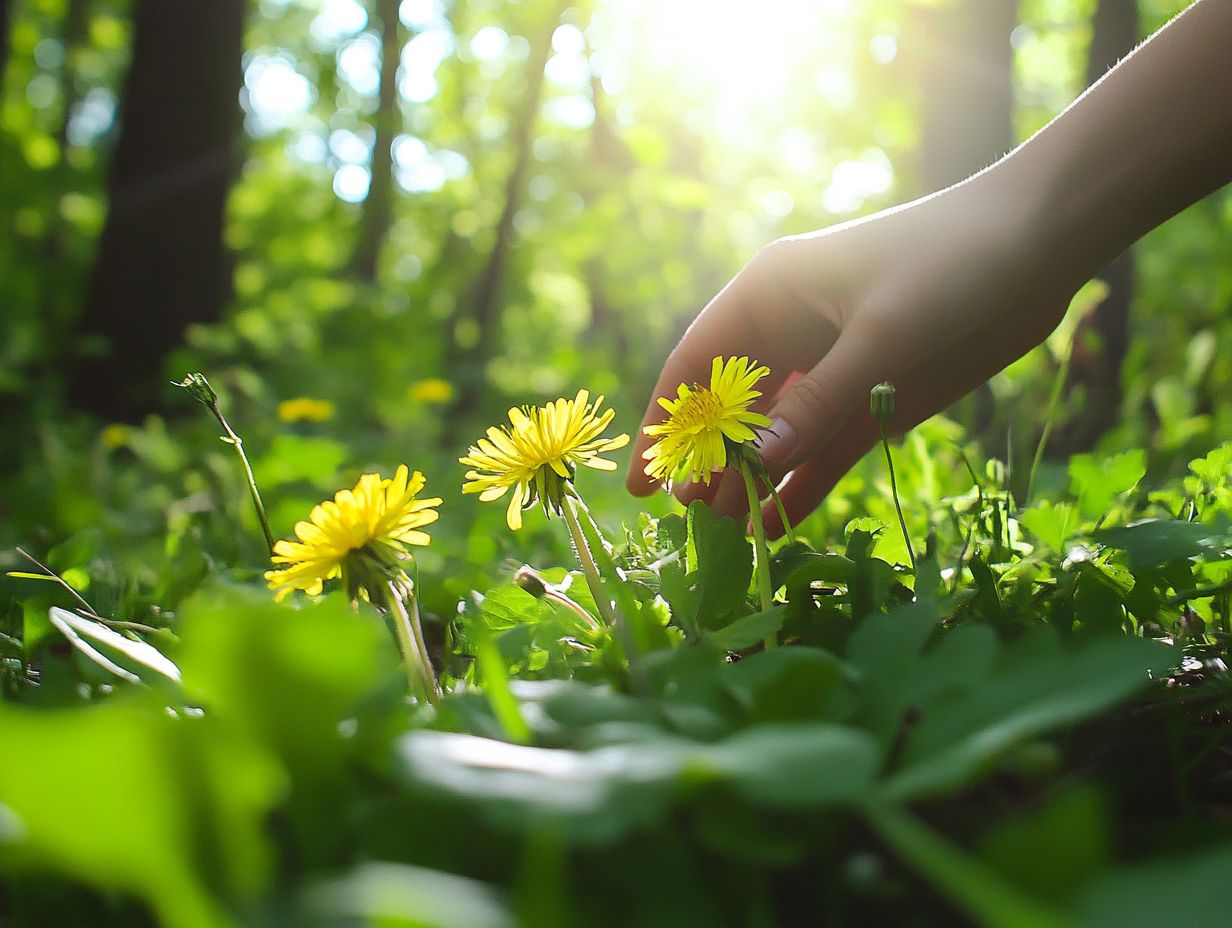
Fiddleheads, those charming curled young fronds of ferns, are a seasonal treasure you can forage in early spring. They bring a unique flavor profile and a host of health benefits, making them an enticing addition to your wild edible plants repertoire.
The ostrich fern is the most popular type, easily recognized by its vibrant green hue and smooth texture. These greens delight your taste buds with a blend of earthy and nutty flavors while being loaded with nutrients like antioxidants and omega-3 fatty acids.
When harvesting, practice sustainability by picking only a few fronds from each plant, allowing them to flourish for future seasons. Experiment with cooking methods steam, saut , or toss them in salads to maximize their flavor and nutritional benefits.
Incorporating fiddleheads into your diet can positively impact heart health and overall wellness.
5. Morel Mushrooms
Morel mushrooms, with their distinctive honeycomb appearance and earthy flavor, are some of the most coveted wild edibles that grace the spring landscape. Foragers are captivated by their culinary versatility and unique characteristics.
Recognizable by their hollow stems and caps adorned with deep pits, morels are a delight for those in the know. However, it s essential to forage with caution, as some toxic imposters, like the poisonous false morels, resemble them closely. Proper identification is crucial for a safe foraging adventure.
The prime time for harvesting morels spans from late March to early June, depending on your location. They thrive in damp, wooded areas.
For preparation, a quick saut is the best method, allowing their rich flavors to shine. Nutritionally, they offer a fantastic profile low in calories yet high in vitamins D and B making them a delicious and healthy addition to elevate any meal.
What Is Spring Foraging and Why Is It Popular?
Spring foraging is an artful practice that invites you to seek out and gather wild edible plants during the early spring months. As nature stirs to life, it reveals an abundance of delicious and nutritious options, including 5 edible plants for beginners to forage, making this activity increasingly popular among culinary enthusiasts and health-conscious individuals alike.
This rising interest is due to a heightened awareness of sustainable eating habits, minimizing your ecological footprint by embracing locally sourced foods. Many find joy in the reconnection with nature that foraging offers, turning a simple outing into an exhilarating exploration of wild bounty.
For those venturing into this world for the first time, backyard foraging serves as an accessible gateway. It allows you to discover the joys of gathering greens, berries, and more, often yielding delightful surprises and fostering a deeper appreciation for local ecosystems.
Get out there and discover the wild edibles waiting for you!
What Are the Benefits of Foraging for Edible Plants?
Foraging for edible plants opens up a world of benefits for you. It grants access to nutrient-rich foods and deepens your connection to nature. It also reveals the medicinal properties found in many wild plants, enriching both your diet and overall well-being.
Beyond personal health, foraging offers significant environmental benefits. The foods you gather promote the growth of native species, in contrast to traditional farming practices that often lean on monocultures large areas planted with a single crop and chemical fertilizers. This sustainable approach helps combat soil degradation and nurtures a harmonious relationship with the ecosystem.
As you engage in the art of foraging, you cultivate mindfulness. Immersing yourself in the search for edible flora fosters a deeper appreciation for nature s rhythms and the intricate web of life that supports us all.
What Are the Precautions to Take When Foraging for Edible Plants?

When foraging for edible plants, taking several precautions is essential to ensure your safety. Thorough plant identification and awareness of your surroundings are key, especially when exploring the best edible flowers for foraging, as some wild plants can easily be mistaken for toxic varieties.
To effectively distinguish between what you can eat and what you should avoid, consider using reliable field guides or enrolling in an online plant identification course. These resources focus on various species, including miner s lettuce and wildflowers, offering accurate information and visual references that significantly enhance your foraging skills.
It s also vital to practice safe harvesting methods. Always collect plants from pollution-free areas and avoid overharvesting to promote sustainability. Stay vigilant about identifying hazardous plants by familiarizing yourself with common look-alikes. Even minor mistakes in identification can lead to serious health risks, so a keen eye is your best ally in the wild.
How Can One Incorporate Foraged Plants into Their Diet?
Dive into the world of foraged plants! Imagine crafting vibrant wild salads and tasting flavors you’ve never experienced before. Incorporating the most nutritious edible plants to forage into your diet can be an exciting culinary adventure.
To embark on this journey, consider adding wild herbs like dandelion greens or nettles to your salads for a delightful peppery kick. You might also blend foraged mushrooms, such as chanterelles, into creamy risottos for an exquisite touch. For more inspiration, check out 5 wild plants to forage this winter.
When preparing these ingredients, a gentle wash and minimal cooking will help retain their remarkable flavors and nutrients. Pairing these foraged delights with local cheeses, like goat or feta, can transform a simple dish into something extraordinary, showcasing the unique characteristics of wild edibles. For those interested in further enhancing their foraging skills, refer to this guide on how to identify edible plants in spring, including wild asparagus and wild violets.
What Are the Best Practices for Sustainable Foraging?
Sustainable foraging practices are not just beneficial; they are essential for preserving wild ecosystems. This includes enjoying the bounty of nature, such as morel mushrooms and oyster mushrooms. It’s all about responsible harvesting techniques that minimize ecological impact.
To truly practice sustainable foraging, adopt a mindful approach. Take only what is necessary to limit any potential harm to plant populations, such as field garlic and stinging nettle. Understand the specific needs of each ecosystem, recognize the consequences of overharvesting, and respect the delicate balance that nature maintains.
It’s also crucial to educate yourself about the local laws and regulations governing foraging in your area. These guidelines protect native species and enhance your own foraging experience. By being informed and considerate, you can embark on a rewarding journey that honors the land and its resources, ensuring a thriving environment for everyone involved.
Discover Exciting Edible Plants to Forage This Spring!
Spring unveils a variety of wild edible plants, inviting you to venture beyond the usual suspects like chickweed, bittercress, and clover. Exploring the 5 best edible plants for urban foraging can introduce you to treasures that offer unique flavors and nutritional benefits for your foraging adventures!
These delightful finds not only elevate your meals but also forge a deeper connection with the natural world. Immerse yourself in the vibrant greens that surround you!
Take dandelion, for instance. Its tender leaves add a slightly bitter kick to salads, while the delicate flowers infuse your dishes with a burst of color and sweetness. You can also try wild garlic, whose distinctive aroma can transform your culinary creations and let you savor the essence of the season.
To identify these plants successfully, engage in careful observation. Notice the shapes of the leaves, the colors of the flowers, and their unique growth habits. Share your culinary creations and foraging experiences to enrich your journey and cultivate a community that honors nature s exquisite bounty!
Frequently Asked Questions
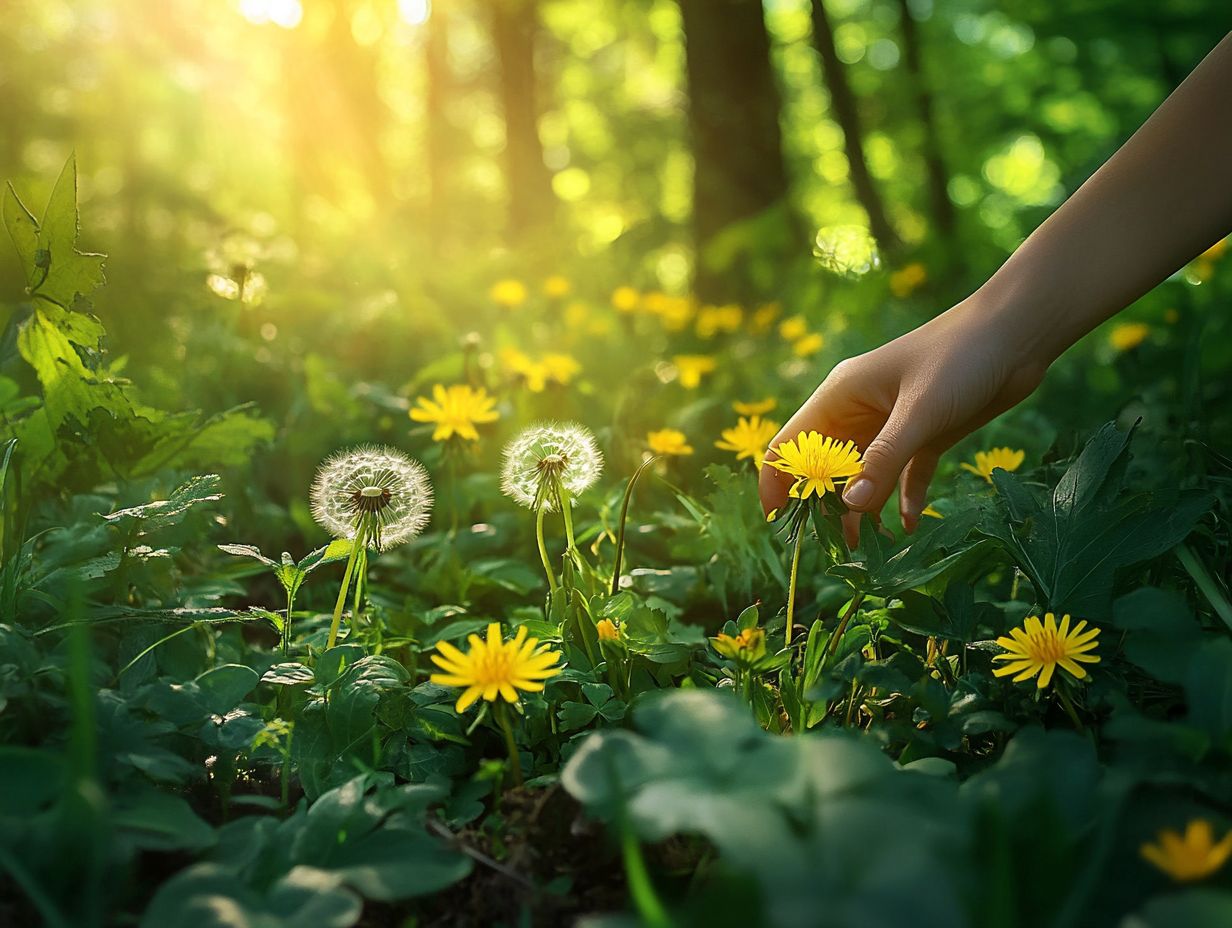
What are the 5 best edible plants for spring foraging?
The 5 best edible plants are stinging nettle, dandelion, chickweed, garlic mustard, and wild ramps.
How do I prepare stinging nettle for consumption?
Stinging nettle can be steamed, blanched, or saut ed and used in dishes like soups, pesto, and teas.
Can I eat dandelion flowers and roots?
Yes! Both dandelion flowers and roots are edible. Use the flowers in salads or as tea, and roast the roots as a coffee substitute.
What is the best way to identify chickweed?
Chickweed has small white flowers with five petals, and oval-shaped leaves that are opposite each other on the stem. It tastes similar to spinach.
Where can I find garlic mustard for foraging?
Garlic mustard can be found in shady, wooded areas and along trail edges, especially in the eastern and midwestern U.S.
How can I use wild ramps in cooking?
Wild ramps can replace onions or garlic in quiches, stir-fries, and soups. The leaves are also great in salads or pesto.
Get outside and discover these plants today!



